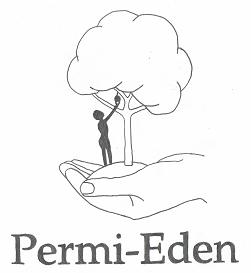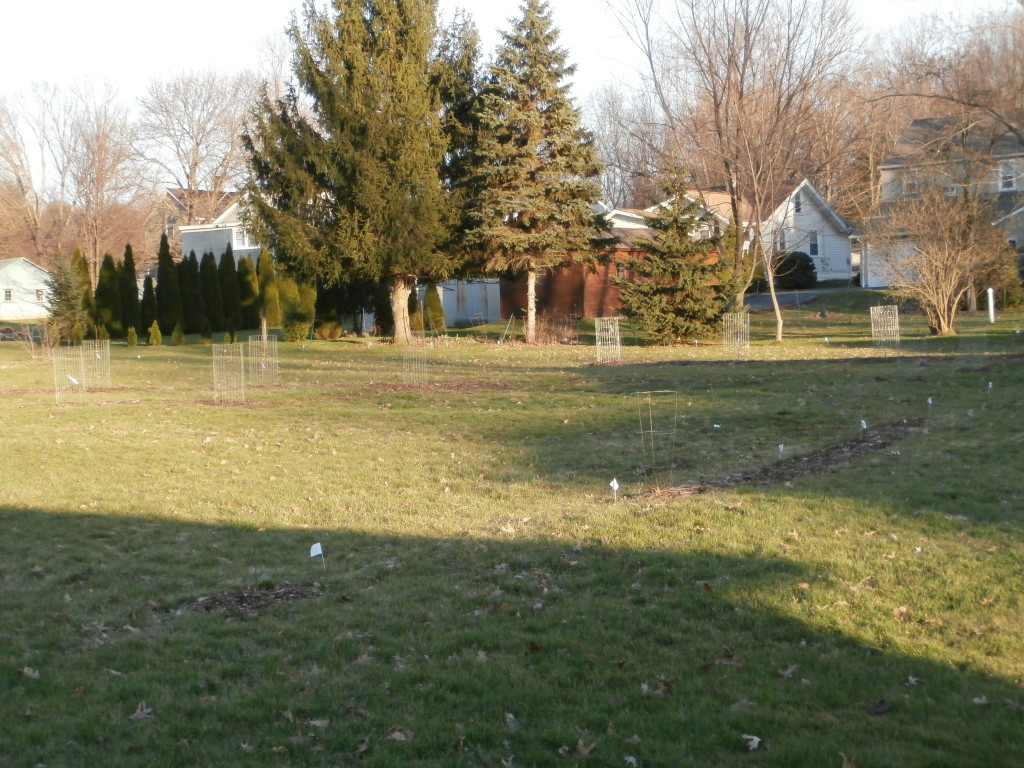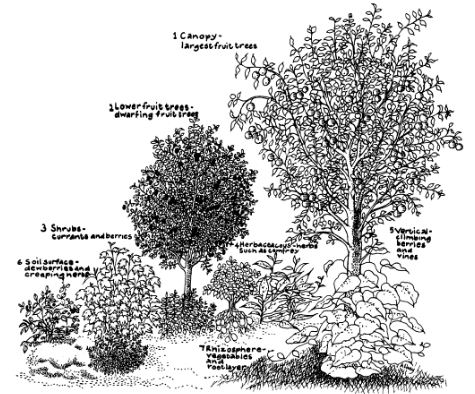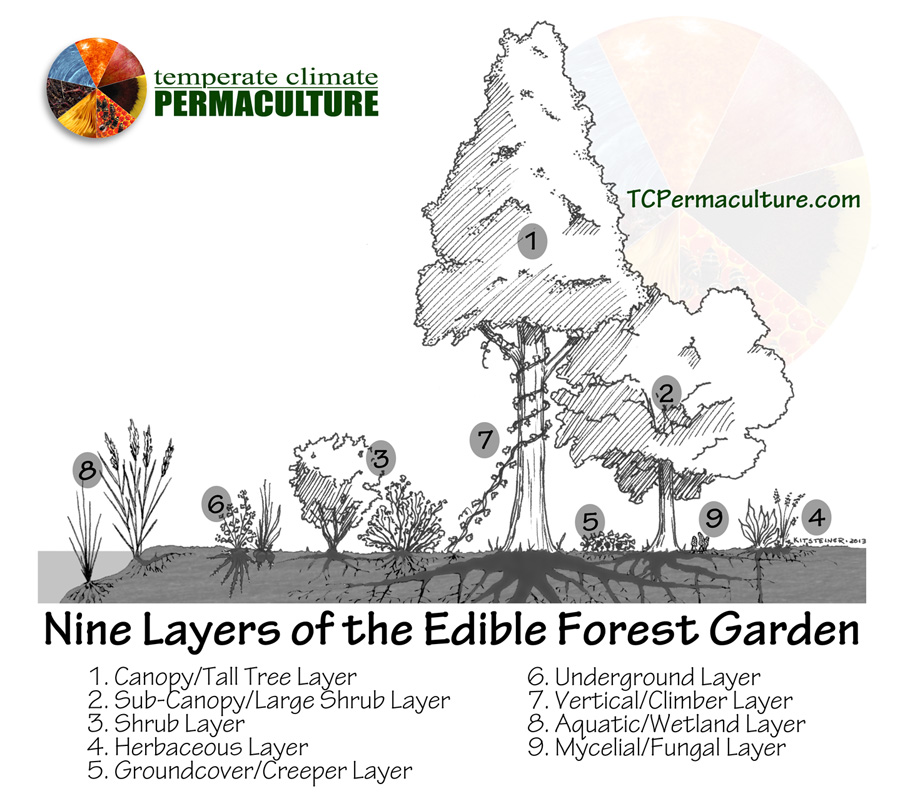Beginning to build a forest of food
- 2014-04-19
- By Jen
- Posted in Let's Grow, Permaculture
Welcome to my enchanting forest. Well, what will become my food forest. See those wire cages? Right now it resembles the begining of an orchard, but that will change over time and the addition of many more plants.
What is a food forest? Wikipedia’s formal definintion is “Forest gardening is a low-maintenance sustainable plant-based food production and agroforestry system based on woodland ecosystems, incorporating fruit and nut trees, shrubs, herbs, vines and perennial vegetables which have yields directly useful to humans. Making use of companion planting, these can be intermixed to grow in a succession of layers, to build a woodland habitat.“ Whew, that is a mouthful. Essentially, it is a system of usually perennial plants that are edible, medicinal or have other functions that are put together in a way that mimics a forest.
When building a food forest, the general “rules” are that there are layers of plants. Most of the time they are defined as seven different layers, as you can see in this sketch by Robert Hart.
There are times that people add a few additional layers, taking the count up to nine, as can be seen in this sketch by TCPermaculture.
Not all food forests have to have all layers, but having a vareity of layers is standard. Otherwise it wouldn’t be a forest, now would it?
LAYER 1 – This layer is reserved for the edges of my yard. It includes walnut, pecans, butternut and mulberries. These trees can get to 70+ foot tall.
LAYER 2 – In the central portion of the yard, which you see in the first picture of this post and what I am really defining as the main food forest area, the “tall” layer will be various fruit trees (apple, pear, nectarine, apricot, peach, plum and paw paw) and nut trees (almond and chestnut). There will also be autumn olive in that layer, temporarily, as a nitrogen fixing element, but it might never be allowed to get to full height, even though edible. I will probably keep it coppiced every year to encourage the fixing of the nitrogen and to add other nutrients back to the soil. That layer will be 15 – 30 foot.
LAYER 3 – The shrub layer, which contains woody bushes and shrubs, will have another nitrogen fixer, sea buckthorn/seaberry, will be in this layter to help support the fruit and nut trees and kick them into overdrive with their growth. I have also added currants and gooseberries and might add in some blueberries too, but currently those are scattered in other areas of my yard. I will also have the option to propagate honeyberries and elderberries that are installed in other places in the yard and add them to the system as well. This layer is not just reserved for fruit, though. There are also some bush hazelnuts and some chinkapin bush chestnuts too. This layer is typically 4 – 10 foot.
LAYER 4 – The herbacious layer is comprised of non-woody plants. Right now, as the food forest gets built, it will be heavily occupied by annual vegetables. I imagine there will always be some mixed in, but the annual vegetables will be reduced in number as the perennial plants increase and really take hold. This layer will also contain comfrey, herbs (to help attract pollinators and beneficial insects) and flowers, like daffodils (to keep voles at bay) and other medicinal and pollinator supporting flowers. Typically most plants in this layer would be under 3 foot.
LAYER 5 – The ground cover/creeper layer can consist of annual vegetables and fruits like watermelon, squash and sweet potatoes. On the perennial side of things, wintergreen, creeping cranberries and other berries are good options. This layer is useful to help shade the soil and retain moisture in the system, reducing the need to irrigate or water during dry spells. This layer is made of plants 1 foot or less in height with a spreading/creeping nature.
LAYER 6 – The subsurface underground layer is all of those wonderful root crops. Carrots, turnips, parsnips and radishes are stars in this layer. A couple of things which I haven’t decided if they belong in this layer would be potatoes (could be classified in this layer and herbacious too), the sweet potatoes mentioned in the ground cover layer, peanuts (someone sent me some peanuts that were grown in Michigan and I might give them a try more out of curiosity). I could put jerusalem artichokes possibly in this or the herbacious layer, but they will not be directly introduced into this system. They will get their own, confined, space elsewhere in the yard.
LAYER 7 – For climbers, you could use perenials like Good King Henry and groundnut (again, does this fall in the underground layer?). You could add in annuals like peas and beans, which would be great for nitrogen fixing. You could also trellis cucumbers up in they system. Some people have added fruit vines like grapes and kiwi. With the primary, central portion of my system being zone 2 and below, I think that I will keep those in other areas so that I don’t have to maintain them as intensively as I suspect that I would if they were in the main body of the food forest system.
LAYER 8 – If I build the pond that I hope to some day, I will have this layer, but it will be at the outskirts of the food forest. Things like wild rice, water chestnuts, watercress and cattails all can be a part of this layer.
LAYER 9 – Since I will be keeping woodchips on the surface, the fungal layer would be a natural fit for mushrooms. The decomposition of the woodchips will not only help to build the soil, but it will increase the overall fungal activity in the soil, even without mushrooms present. Since it will be likely that unwanted mushrooms will migrate into the woodchips, it would be best to innoculate with kinds that are edible before the undesirable, poisonous ones move in. I want to know what I am putting in and don’t want to take my chances with identification on these.
I have started the process of installation and still have a long way to go. Diversity in this type of system is key to it being healty. Sort of like us and what we eat. We need a wide variety of minerals, vitamins and other nutrients to be healthy. So do our plant systems. By adding a diverse variety of plant, trees and bushes, they all can return a different set of minerals and nutrients to the system through their trimmings being “chopped and dropped” and through their leaf fall. The variety of plants will also be host to numerous insects, birds and other wildlife (maybe even frogs and snakes – eek!) which will help to balance out the undesirable insects and other critters in the system. By not focusing on one type of plant only in one spot, but by scattering things through the system, it will help to confuse the undesirables and regulate their populations. They won’t be able to belly up to a smorgasboard of their favorite plant (think the same things in rows in convention gardens), but they will have to really work to find what they want if there is only one plant here and there, scattered about. This will make them more vulnerable and increase the chance that they will become dinner themselves.
All this diversity, whether it be plant or insect, will take time. Patience will be key. There will be times, I am sure, where it seems like the entire system will be taken out by one kind of pest, but with patience, the beneficials, their arch nemesis, will arrive and start to balance things out. It reminds me of the movie Field of Dreams…build it and they will come.



